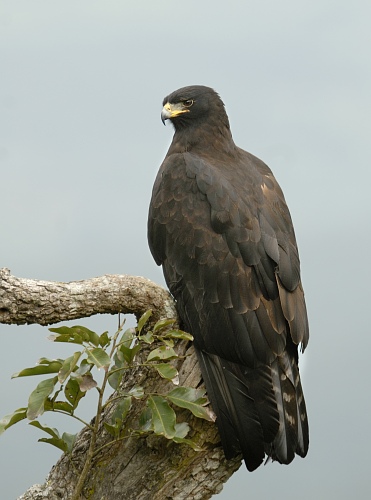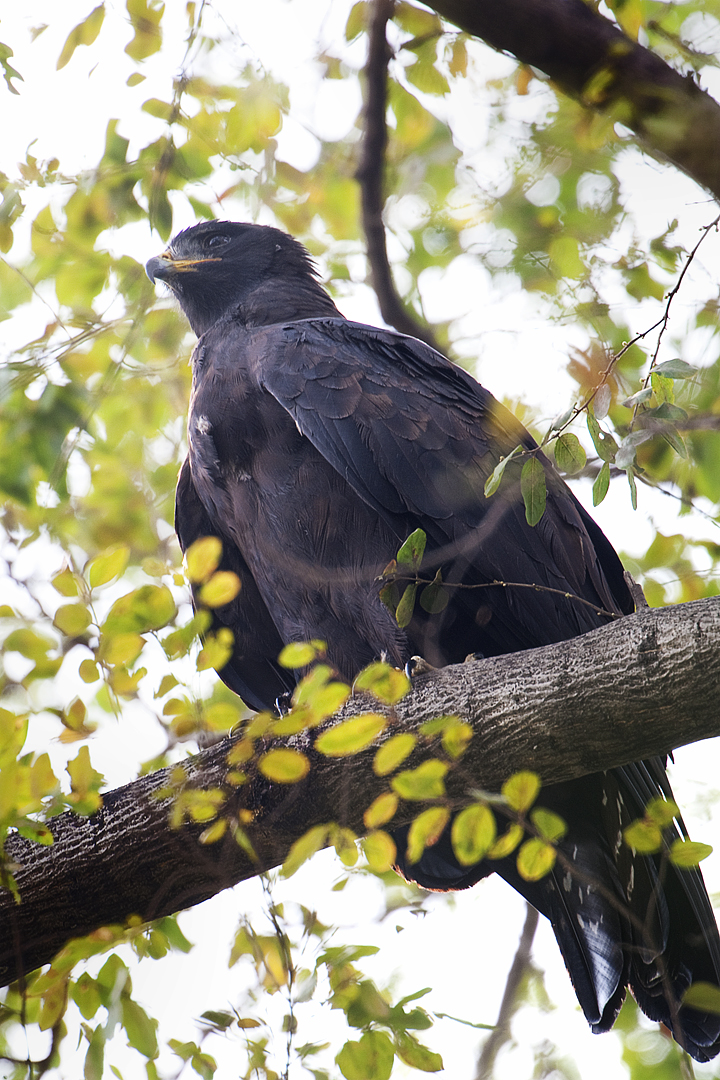Black Eagle - Ictinaetus malayensis
By Kalyanvarma, Public Domain, via Wikimedia Commons
Family: Accipitridae
Genus: Ictinaetus
Species: I. malayensis
Subspecies: I. m. malayensis, I. m. perniger (Indian Black Eagle)
Black Eagles are large, forest-dwelling raptors that occur along a range that spans from Pakistan and Indochina to the Malay Peninsula.
Physical Description:
Black Eagles are, as their names indicate, almost entirely black. They have a yellow cere and feet, and the eyes are brown. The beak is yellow to gray with a black tip. There are often white patches at the base of the primary feathers and the undertail coverts, and the wings are large relative to their body size with long, extended primary feathers. The claws are not as curved as those of some eagles.
Juveniles have a dark brown crown, nape, back, and wings. They are speckled with a buff yellow color, and the tail is barred with gray. Heavily streaked along the belly and thighs, with underparts streaked with black.
Size:
Length: 69-81 cm
Weight: 1-1.6 kg
Habitat and Distribution:
Black Eagles occupy lowland, evergreen, and montane forests, from 0-4,000 meters above sea level. They prefer slopes and mountainous country and areas where there is forest cover.
There are approximately 10,000-100,000 birds spread from northeastern Pakistan and the base of the Himalayas through Bhutan, India, and Sri Lanka, and down into Indochina and Malaysia, from 34° to 9°S. Adults are partial migrants.
Diet and Hunting:
Black Eagles eat mammals such as bats, rats, squirrels, flying squirrels, along with other small animals including reptiles, frogs, insects, and some birds. They are also known to snatch up entire nests, eating nestlings and eggs.
They hunt by soaring over forests, creeks and rivers, ridges, and other open areas. Their long primaries may be so distinct because of this hunting technique, helping them to fly at slow speeds so they can spot prey. Once they have found a target, they swoop down and grab it with their claws. Black Eagles are also known to forage in pairs.
By Tarique Sani, CC-BY-NC-SA-2.0, via Flickr
Reproduction:
The breeding season is from November-March in southern India and April-August in Java. Displays consist of aerial maneuvers, including dives where the bird pulls its feathers close to its body to form a heart-shaped silhouette. Pairs will also chase each other through the forest and perform sky-dances.
Black Eagle nests are large, around 1.2 meters wide, with a stick platform and made of twigs, usually set in the fork of a tree with a dense canopy above. Often a pair will have several different nests, all of them maintained, and they are used year after year. A clutch of 1-2 eggs is laid and incubation lasts approximately 35-40 days. Fledging takes 60 days. To keep it in good condition, fresh leaves are brought to the nest daily.
Conservation:
Black Eagles face threats from deforestation, but the decrease in their population is not rapid enough from them to be considered Vulnerable. They are currently listed as Least Concern by BirdLife International.
Taxonomy:
Subspecies:
There are two subspecies of Ictinaetus malayensis: I. m. malayensis, which occupies the Malay peninsula, Indochina, and parts of China, and I. m. perniger (Indian Black Eagle), which lives in northern India and Pakistan.
Other Names:
Asian Black Eagle, Indian Black Eagle, Orel indomalajský (Czech), Indisk Sortørn (Danish), Indische zwarte arend (Dutch), Krattkotkas (Estonian), Rosvokotka (Finnish), Aigle noir (French), Malaienadler (German), Elang hitam (Indonesian), Aquila nera indiana (Japanese), Helang Hitam (Malay), Svartørn (Norwegian), Orlik malajski (Polish), Aguila Milana (Spanish), Svartörn (Swedish).
Other Multimedia:
References:
http://www.arthurgrosset.com/asiabirds/indianblackeagle.html
http://avibase.bsc-eoc.org/species.jsp?avibaseid=28D7E7CCE03B9442
BirdLife International (2011) Species factsheet: Ictinaetus malayensis. Downloaded from
http://www.birdlife.org on 31/07/2011.
Global Raptor Information Network. 2011. Species account: Indian Black Eagle Ictinaetus malayensis. Downloaded from
http://www.globalraptors.org on 31 Jul.
2011
http://www.gwannon.com/species/Ictinaetus-malayensis
http://ibc.lynxeds.com/species/indian-black-eagle-ictinaetus-malayensis
BirdLife International 2009. Ictinaetus malayensis. In: IUCN 2011. IUCN Red List of Threatened Species. Version 2011.1.
www.iucnredlist.org. Downloaded on 31 July 2011.
http://www.mangoverde.com/birdsound/spec/spec30-204.html
http://www.nps.gov/akso/parkwise/students/referencelibrary/general/migrationbasics.htm
http://www.pbase.com/makus/black_eagle
http://www.planetofbirds.com/accipitriformes-accipitridae-black-eagle-ictinaetus-malayensis
Ferguson-Lees, James, and Christie, David A. Raptors of the World. Houghton Mifflin Company, 2001.
http://www5b.biglobe.ne.jp/~raptor/IBE-Leaflet.pdf

